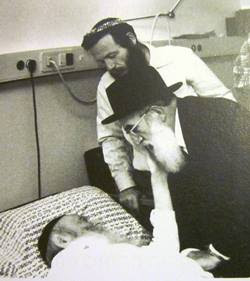
When Rav Tzvi Yehudah was hospitalized in Jerusalem’s Sha’arei Tzedek hospital, suffering from intense pain in his legs, I went to visit him.
In great pain, the rabbi was moaning. As a student who felt very close to him, it was difficult for me to witness his distress. When I saw his state and heard his groans, I groaned too.

Chief Rabbi Shlomo Goren visiting Rav Tzvi Yehudah Kook in the hospital
A month after Rav Tzvi Yehudah was released from the hospital and returned to teach at the yeshiva, the rabbi approached me.
“Don’t you think it is time you learned the laws of bikurcholim, the proper way to visit the sick?”
I had no idea what the rabbi was talking about.
Then he explained, “When visiting the sick, one should be upbeat and cheer them up. One shouldn’t groan, ‘Oy, oy….'”
“You are probably wondering,” the rabbi continued, “why I didn’t mention this to you right away. At the time, I was disturbed by your conduct, and I didn’t want to reprimand you while I was still upset.”
With Joy
Rav Kook (the father) offered similar guidance about how one should visit the sick. During his final illness, he urged those who came to visit him to perform the mitzvah of bikurcholim with simchah, with joy.
He quoted a letter of Maimonides, who explained that the primary goal of this mitzvah is to encourage the sick so that they will not despair and give up hope. Therefore it is clear that visitors should display a cheerful and optimistic attitude.
Additionally, Rav Kook noted, visiting the sick is a mitzvah. It should be performed with joy, like any other mitzvah in the Torah.
(Note: this lesson can be extended to phone calls, whatsapp and zoom!)
(Stories from the Land of Israel. Adapted from Mashmia Y'shuah, p. 567; Malachim Knei Adam, p. 417, sent by Rabbi Chanan Morrison, ravkooktorah.org)
See also: Shemini: Immersion in Water





